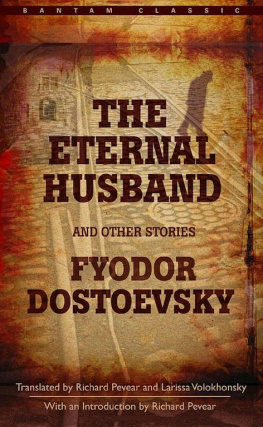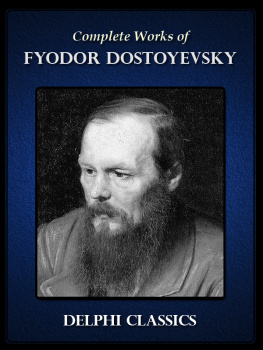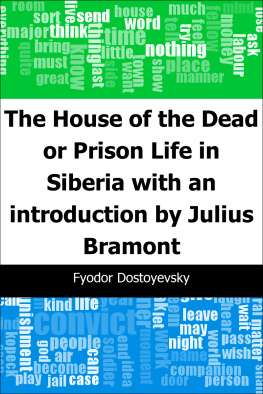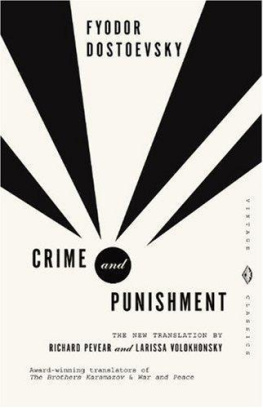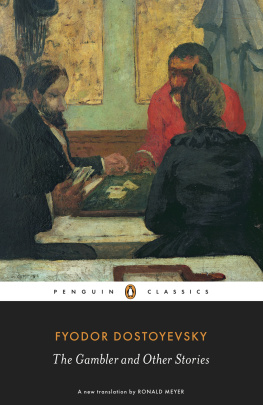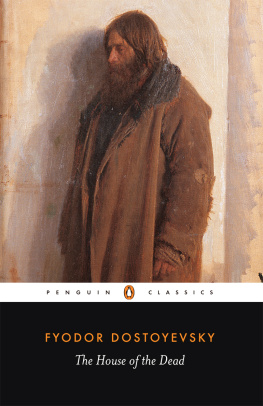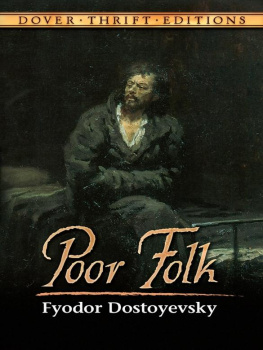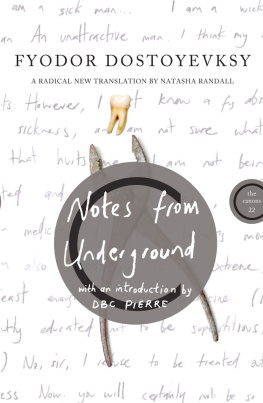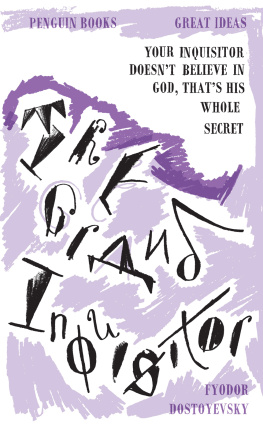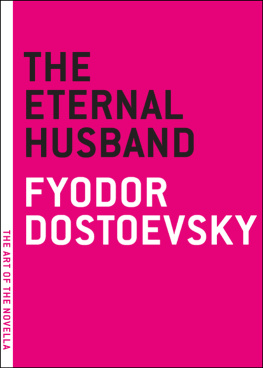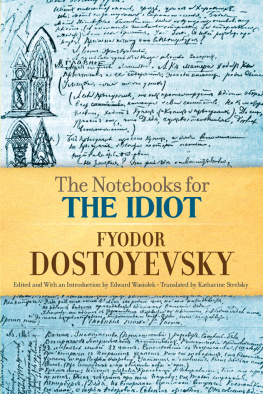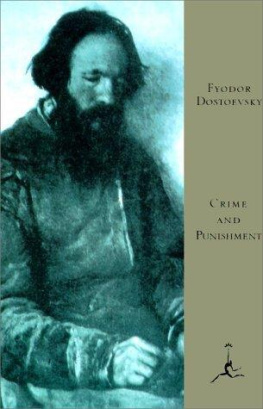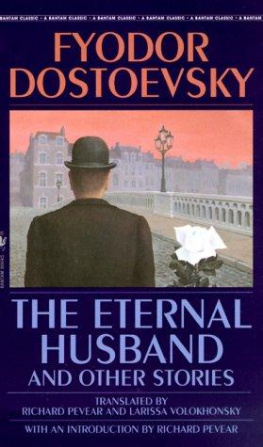Fyodor Dostoyevsky - The Eternal Husband and Other Stories
Here you can read online Fyodor Dostoyevsky - The Eternal Husband and Other Stories full text of the book (entire story) in english for free. Download pdf and epub, get meaning, cover and reviews about this ebook. year: 1997, publisher: Bantam Books, genre: Art. Description of the work, (preface) as well as reviews are available. Best literature library LitArk.com created for fans of good reading and offers a wide selection of genres:
Romance novel
Science fiction
Adventure
Detective
Science
History
Home and family
Prose
Art
Politics
Computer
Non-fiction
Religion
Business
Children
Humor
Choose a favorite category and find really read worthwhile books. Enjoy immersion in the world of imagination, feel the emotions of the characters or learn something new for yourself, make an fascinating discovery.
- Book:The Eternal Husband and Other Stories
- Author:
- Publisher:Bantam Books
- Genre:
- Year:1997
- Rating:5 / 5
- Favourites:Add to favourites
- Your mark:
- 100
- 1
- 2
- 3
- 4
- 5
The Eternal Husband and Other Stories: summary, description and annotation
We offer to read an annotation, description, summary or preface (depends on what the author of the book "The Eternal Husband and Other Stories" wrote himself). If you haven't found the necessary information about the book — write in the comments, we will try to find it.
The Eternal Husband and Other Stories — read online for free the complete book (whole text) full work
Below is the text of the book, divided by pages. System saving the place of the last page read, allows you to conveniently read the book "The Eternal Husband and Other Stories" online for free, without having to search again every time where you left off. Put a bookmark, and you can go to the page where you finished reading at any time.
Font size:
Interval:
Bookmark:
FYODOR MIKHAILOVICH DOSTOEVSKYs life was as dark and dramatic as the great novels he wrote. He was born in Moscow in 1821, the son of a former army surgeon whose drunken brutality led his own serfs to murder him. A short first novel, Poor Folk (1846), brought him instant success, but his writing career was cut short by his arrest for alleged subversion against Tsar Nicholas I in 1849. In prison he was given the silent treatment for eight months (guards even wore velvet-soled boots) before he was led in front of a firing squad. Dressed in a death shroud, he faced an open grave and awaited his execution when, suddenly, an order arrived commuting his sentence. He then spent four years at hard labor in a Siberian prison, where he began to suffer from epilepsy, and he returned to St. Petersburg only a full ten years after he had left in chains.
His prison experiences coupled with his conversion to a profoundly religious philosophy formed the basis for his great novels. But his fortunate marriage to Anna Snitkina, despite a period of utter destitution brought about by his compulsive gambling, gave Dostoevsky the emotional stability to complete Crime and Punishment (1866), The Idiot (186869), Demons (187172), and The Brothers Karamazov (187980). When Dostoevsky died in 1881, he left a legacy of masterworks that influenced the great thinkers and writers of the Western world and immortalized him as a giant among writers of world literature.
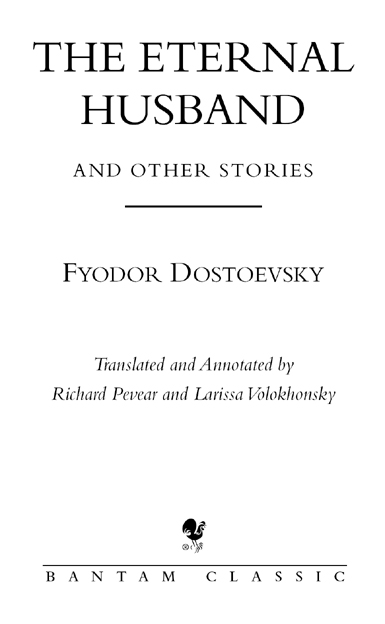
THE ETERNAL HUSBAND
A Bantam Book
PUBLISHING HISTORY
Bantam trade paperback edition published October 1997
Bantam mass market edition published September 2000
Bantam mass market reissue / December 2008
Published by Bantam Dell
A Division of Random House, Inc.
New York, New York
This is a work of fiction. Names, characters, places, and incidents either are the product of the authors imagination or are used fictitiously. Any resemblance to actual persons, living or dead, events, or locales is entirely coincidental.
All rights reserved
Bantam Books and the rooster colophon are registered trademarks of Random House, Inc.
eISBN: 978-0-307-79361-4
www.bantamdell.com
v3.1
It is the road of every Christian man, who starts from the senses, who is endowed with reason as a dialectical principle which, in the drama of his earthly life, must make a decision between ever increasing participation and eternal defection.
ERICH AUERBACH,
DANTE, POET OF THE SECULAR WORLD
D OSTOEVSKYS WORK represents a life-long meditation on the same few themes, motifs, and figures. The love triangle, for instance, with all its ambiguities of pride and humiliation, outward magnanimity, and inner rivalry, entered his work with his very first book, Poor Folk, finished in 1845, when he was twenty-four. Some ten years later, after passing through many of his early stories (The Landlady, A Faint Heart, White Nights), the motif entered the writers own life in the form of his friendship with the Isaev family in Semipalatinsk and his later courtship of the widowed Marya Dmitrievna Isaev. Marya Dmitrievna eventually became his first wife, but before accepting his proposal she hesitated for a long time between Dostoevsky and a young schoolteacher by the name of Vergunov. Dostoevsky thus got to play two rolesthe family friend who falls in love with the mistress of the house, and then the older rival of a handsome young suitor. The various moves of this elaborate game are detailed in the letters he wrote at the time, which read like pages from one of his own epistolary tales. So he found himself in situations he had already portrayed and would portray again and again in his later novels, culminating in the three (or four) interlocking love triangles of The Brothers Karamazov. This close exchange between life and literature, with literature sometimes strangely anticipating life, is a Dostoevskian feature.
The figure of the dreamer also entered Dostoevskys work with Poor Folk, took a central part in much of his early writing, both fiction and journalism, re-emerged quite changed in Notes from Underground (1864), and continued to appear in virtually all his later work. Mikhail Bakhtin notes in Problems of Dostoevskys Poetics: Dostoevsky made very wide use of the artistic possibilities of the dream in almost all its variations and nuances. Indeed, in all of European literature there is no writer for whom dreams play such a large and crucial role as Dostoevsky. We must distinguish, however, between the dreamer and the dream, because dreaming takes two main forms in Dostoevsky. The first is the form of a reverie produced by the dreamer, who longs to transform the squalid reality around him into something nobler, loftier, more beautiful. The dreamer is a fervent idealist, a great reader of German romantic poetry, but his consciousness is isolated and he usually ends badly. Reality triumphs. Yet the dreamers aspirations receive a backhanded vindication: aesthetically he is right; art and sensibility are exalted in his person above the meanness of the world. The bubble of this sort of romantic dreaming, which Dostoevsky himself indulged in as a young liberal of the 1840s, was definitively pricked in Notes from Underground. There the dreamer becomes a far more complex and contradictory figure; his tone changes from sentimental idealism to bitter sarcasm, much of the sarcasm directed against himself and his own former dreams: to tell long stories of how I defaulted on my life through moral corruption in a corner, through an insufficiency of milieu, through unaccustom to what is alive, and through vainglorious spite in the undergroundis not interesting, by God; a novel needs a hero, and here there are purposely collected all the features for an anti-hero Isolated consciousness has recognized its isolation. This recognition marked all of Dostoevskys work after Notes.
The second form dreaming takes in Dostoevsky is that of an unexpected and intense vision, which comes to the dreamer in sleep as a gift or a final revelation, a living image that awakens him to a truth he had not suspected or had not understood before. Such are Alyoshas dream of the messianic banquet and Mityas dream of the wee one in The Brothers Karamazov. These are confirming, saving dreams. They have a negative counterpart, ultimately serving the same purpose, in the nightmares of Raskolnikov and Svidrigailov in Crime and Punishment, of Stavrogin in Demons, and finally in Ivan Karamazovs hallucination of the devil.
With his second book, The Double (1846), another key motif of Dostoevskys work appears. The story tells about the emergence of a Mr. Golyadkin Jr. in the government office where the petty clerk Golyadkin serves, a parody and rival of himself who eventually drives him mad. Mr. Golyadkin Sr. is a proud man and keeps aloof from his fellow clerks; his double is the reverse. Golyadkin Sr. says of him: He has such a playful, nasty character Hes such a scoundrel, such a fidget, a licker, a lickspittle, but then adds, such a Golyadkin. Here Dostoevsky first came upon the surprising truth that pride, far from unifying and fortifying the person, as we might think, is the source of all inner divisions. In The Double it literally splits Mr. Golyadkin in two. Dostoevsky did not repeat this bold artistic experiment, which in fact never satisfied him, but the motif of the double occurs in subtler forms throughout his work. It raises by implication the question of human unity, the oneness of the person and of mankind, which Dostoevsky explored all his lifepolitically in his involvement with revolutionary groups in the 1840s, spiritually in his subsequent religious meditations.
Next pageFont size:
Interval:
Bookmark:
Similar books «The Eternal Husband and Other Stories»
Look at similar books to The Eternal Husband and Other Stories. We have selected literature similar in name and meaning in the hope of providing readers with more options to find new, interesting, not yet read works.
Discussion, reviews of the book The Eternal Husband and Other Stories and just readers' own opinions. Leave your comments, write what you think about the work, its meaning or the main characters. Specify what exactly you liked and what you didn't like, and why you think so.

